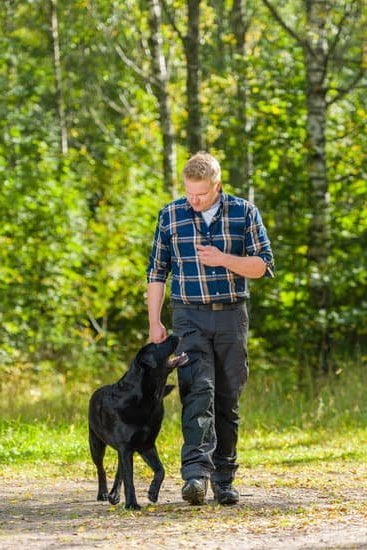Are you wondering how to train your dog not to sleep on the bed? It is essential to establish a designated sleeping area for your furry friend, not only for their comfort but also for your own well-being. Dogs are often drawn to sleeping on their owners’ beds due to a sense of security and closeness. However, setting boundaries and implementing consistent training methods can help redirect this behavior.
Having a designated sleeping area for your dog provides them with a space that they can call their own, promoting better rest and relaxation. This separation also helps maintain hygiene and cleanliness in your bedroom, as dogs may bring dirt, fur, or even parasites into the bed. By understanding why dogs are attracted to sleeping on beds, you can effectively address this behavior through positive reinforcement and creating a comfortable alternative.
Establishing clear rules and consistently enforcing them is key in training your dog not to sleep on the bed. Providing a cozy and inviting dog bed as an alternative will encourage your pup to choose their own space over yours. Positive reinforcement techniques such as rewards and praise can further motivate them to adhere to these rules. Remember, patience and consistency are paramount in successfully teaching your dog where they should sleep.
Understanding Your Dog’s Behavior
Dogs have a natural instinct to seek out cozy and warm places to rest, which can often lead them to gravitate towards sleeping on our beds. Understanding why dogs are attracted to sleeping on beds is crucial in effectively training them to sleep in their designated area.
One reason for this behavior is the strong bond and desire for closeness that dogs have with their owners. Sleeping on the same surface as their human provides a sense of security and comfort for many dogs.
Additionally, sleeping on our beds allows dogs to be close to our scent, which can be soothing and reassuring for them. Dogs have a keen sense of smell, and being near your scent can help them feel connected and safe. It’s important to recognize these instincts and desires when working on training your dog not to sleep on your bed. By understanding why they are drawn to your bed, you can better address their needs and provide alternative solutions.
Implementing boundaries and consistent training methods will be essential in teaching your dog where they should sleep. By establishing clear rules and using positive reinforcement techniques, you can guide your dog towards using their own comfortable bed. Remember that consistency is key in enforcing these rules – it may take time for your dog to adjust, but with patience and persistence, they will learn where they are expected to sleep.
Setting Boundaries
Consistent Training
When it comes to teaching your dog not to sleep on your bed, consistency is crucial. Dogs thrive on routine and clear boundaries, so it’s essential to establish rules that are consistently enforced. Make sure that everyone in the household is on board with the training plan and follows the same guidelines. This will prevent confusion for your pup and make it easier for them to understand what is expected of them.
Setting Clear Boundaries
One way to set clear boundaries is by using positive reinforcement when your dog chooses their designated sleeping area over your bed. For example, reward your dog with treats, toys, or verbal praise every time they willingly go to their own bed instead of yours. This positive association will help them understand that good things happen when they follow the rules.
Redirecting Behavior
If you find your dog attempting to sneak onto your bed despite training efforts, calmly but firmly redirect them to their own bed. Avoid yelling or using physical punishment as this can create fear and confusion in your pet. Instead, continue positively reinforcing their good behavior and redirecting any unwanted behavior consistently. Over time, with patience and persistence, your dog will learn where they are allowed to sleep and respect the boundaries you have established.
Creating a Comfortable Alternative
Dogs love comfort and warmth, which is why they often gravitate towards sleeping on their owner’s bed. To train your dog not to sleep on your bed, it is crucial to provide them with a comfortable alternative that meets their needs. Creating a cozy and inviting dog bed can make all the difference in redirecting your furry friend to their designated sleeping area.
Here are some tips and ideas for creating a welcoming space for your dog:
- Choose a bed that suits your dog’s size and sleeping preferences. Some dogs prefer a plush, cushioned bed while others may enjoy something more firm.
- Place the dog bed in a quiet and peaceful area of your home where your canine companion can relax without disruptions.
- Add some familiar items like their favorite blanket or toy to the dog bed to make it feel more inviting and comforting.
Additionally, consider the temperature of the room where the dog bed is located. Make sure it is not too hot or too cold for your pup, as their comfort level plays a significant role in where they choose to sleep. By providing a comfortable and tailored sleeping space for your dog, you are setting them up for success in breaking the habit of sleeping on your bed.
Remember, consistency is key when training your dog not to sleep on the bed. Stick to the designated rules you have set and be patient as you guide your furry friend towards their new sleeping spot. With love, patience, and a cozy dog bed, you can successfully teach your pup where they should rest at night.
Positive Reinforcement
One effective way to use positive reinforcement is to reward your dog with treats or toys when they choose to sleep on their bed instead of yours. Whenever you see your dog voluntarily settling down in their own space, be sure to provide them with a tasty treat or a favorite toy. This will help them associate their bed with positive experiences and increase the likelihood of them choosing it over your bed.
In addition to treats and toys, verbal praise and affection are also essential components of positive reinforcement. When you catch your dog sleeping on their bed, be sure to shower them with praise and pets.
Dogs thrive on positive attention from their owners, so offering praise when they exhibit the desired behavior will make them more inclined to continue doing so. Remember, consistency is key when using positive reinforcement – be sure to reward and praise your dog every time they choose to sleep on their own bed.
| Positive Reinforcement Techniques | Benefits |
|---|---|
| Rewarding with treats or toys | Associates bed with positive experiences |
| Verbal praise and affection | Boosts motivation for desired behavior |
| Consistency in rewarding | Makes the behavior more likely to be repeated |
Consistency Is Key
Sticking to the Plan
Consistency is crucial when it comes to teaching your furry friend not to sleep on your bed. Dogs thrive on routine, so setting clear boundaries and following through with them is essential. Make sure that everyone in the household is on board with the new rule to avoid confusion for your dog. If you allow your dog on the bed one day and not the next, they will struggle to understand what is expected of them.
Training Techniques
When it comes to training your dog not to sleep on the bed, positive reinforcement is key. Use treats, praise, and toys to reward your pup when they choose their designated sleeping spot over yours. This will help them associate their own bed with good things and encourage them to make the right choice. Additionally, redirecting your dog gently but firmly every time they try to climb onto the bed will reinforce the message that this behavior is not allowed.
Patience Pays Off
It’s important to remember that training takes time, especially when it comes to changing a behavior as ingrained as sleeping on the bed. Be patient with your dog and yourself throughout this process. Consistency in enforcing the no-bed rule will eventually pay off, but it may take some time for your pup to fully adjust.
Stay committed to the training plan and celebrate small victories along the way. With patience and consistency, you can successfully train your dog not to sleep on the bed.
Addressing Separation Anxiety
Separation anxiety can be a common issue that arises when training your dog not to sleep on your bed. Dogs are pack animals, and being close to their human family members can provide them comfort and security. However, it’s important to establish boundaries and teach them that their designated sleeping area is separate from yours.
Here are some tips on addressing separation anxiety during this training process:
- Gradual transition: If your dog has been used to sleeping with you, gradually transition them to their own bed by starting with short periods of time apart and slowly increasing it. This can help lessen their anxiety about the change.
- Comfort objects: Provide your dog with comfort objects such as a favorite blanket or toy in their bed to help them feel secure and relaxed in their own space.
- Positive reinforcement: When your dog chooses to sleep in their own bed instead of yours, be sure to reward them with praise, treats, or extra attention. This positive reinforcement will help reinforce the desired behavior.
By addressing separation anxiety and implementing these strategies, you can help make the transition for your dog from sleeping on your bed to their own more comfortable and less stressful. Remember that patience and consistency are key in training your furry friend to respect boundaries and establish healthy sleeping habits for both of you.
Monitoring Progress
Once you have established the rules and started the training process to teach your dog not to sleep on the bed, it is crucial to monitor their progress regularly. Keep a close eye on your dog’s behavior when it comes to bedtime, especially during the initial stages of training. Observe whether they are choosing their designated bed or attempting to sneak onto yours.
If you notice any slip-ups or instances where your dog tries to climb onto the bed, do not get discouraged. Instead, use these as learning opportunities to adjust your training techniques accordingly. It may be necessary to reinforce the rules more firmly or provide additional positive reinforcement when your dog chooses their bed over yours.
In addition to monitoring your dog’s behavior at night, pay attention to their overall demeanor throughout the day. Changes in behavior such as increased anxiety or restlessness could indicate that your dog is struggling with the new sleeping arrangements. In such cases, it is essential to address any underlying issues promptly and make adjustments to ensure your dog feels comfortable and secure in their designated sleeping area.
Conclusion
In conclusion, training your dog not to sleep on your bed is a process that requires patience, consistency, and understanding. By establishing clear boundaries, creating a comfortable alternative sleeping area, and utilizing positive reinforcement techniques, you can successfully teach your furry friend to respect your space.
It is essential to remember that dogs are creatures of habit and may take some time to adjust to the new rules. Consistency is key in reinforcing the designated sleeping area for your dog. By rewarding good behavior and redirecting any attempts to climb onto the bed, you can effectively communicate the desired behavior to your pet.
Furthermore, addressing any separation anxiety issues that may arise during this training process is crucial. Understanding your dog’s emotions and providing reassurance can help them feel more secure in their own sleeping space. Remember to monitor progress closely and make adjustments as needed. With dedication and perseverance, you can train your dog not to sleep on the bed while strengthening the bond between you both.
Frequently Asked Questions
How Do You Train a Dog Not to Get on the Bed?
Training a dog not to get on the bed requires consistency and patience. You can start by teaching a solid “off” command when they attempt to jump on the bed. Providing them with their own comfy sleeping area is crucial as well.
How Do I Retrain My Dog to Sleep in His Own Bed?
To retrain your dog to sleep in his own bed, you’ll need to establish a positive association with his bed. Encourage him to use his bed by rewarding him for laying in it and gradually increase the duration he spends there.
Why Should Dogs Not Sleep in Your Bed?
Dogs should not sleep in your bed for several reasons. First, it could lead to behavioral issues if they see themselves as equals or above humans in the hierarchy. Secondly, having a separate sleeping area for your dog promotes better hygiene and reduces the risk of allergies or infections being transmitted between you and your pet.

Welcome to the blog! I am a professional dog trainer and have been working with dogs for many years. In this blog, I will be discussing various topics related to dog training, including tips, tricks, and advice. I hope you find this information helpful and informative. Thanks for reading!





